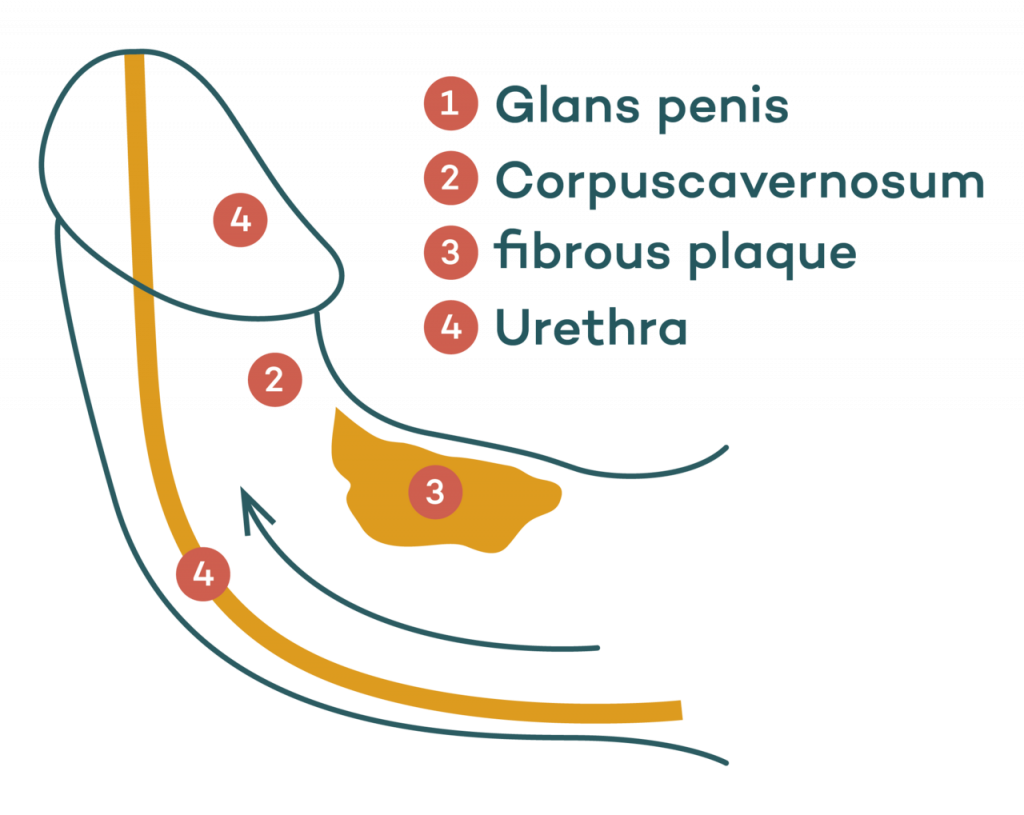A slight curve in your penis is nothing to worry about if it’s not causing you pain or problems when urinating or having sex. A more severe bend or kink could be a sign of Peyronie’s disease and there are options available to treat it and straighten your penis.
What is Peyronie’s disease?
Peyronie’s disease causes plaques (abnormal, fibrous scar tissue) to form around the erectile tissue of the penis. These plaques cause the penis to curve —upwards, downwards or sideways. In a small percentage of cases, plaques grow on both the upper and lower sides, which shortens and distorts the penis.
Peyronie’s disease usually has an acute phase, during which the bending increases and your penis might be painful. You might notice a lump form at the site of the ache and erections might become uncomfortable, painful or softer than usual. The acute phase is followed by a chronic phase when the bend stops changing, and pain becomes less or goes away.

The condition is the result of a problem in the way the body heals wounds. It’s usually caused by an injury to the penis — most often during sex — although many men don’t recall any event before noticing the disease.
Peyronie’s disease can have a significant impact on your mental health. For some people, the bend in their penis can be so severe that they can’t have sex. The bend might be a source of embarrassment, but the effect on your sex life and relationship can have a much bigger psychological impact.
How is Peyronie’s disease treated?
In a small number of cases, Peyronie’s disease will go away on its own. Treatment options to straighten your penis include medicines you can take or have injected into your penis, traction devices and surgery. Men with small plaques, minimal curving of the penis, no pain and no problems with sex may not need to be treated.
Surgery
Surgery is the best way to treat Peyronie’s disease to reduce the curve of your penis and improve functionality. Doctors will only suggest surgery if your condition has been stable and you have had no pain for at least six months.
This is a brief overview of the options, and your doctor can explain more details specific to your condition.
Penis stretching devices
Penile traction therapy with the use of penile traction devices or vacuum erection pumps can help reduce penile deformity in some people with Peyronie’s disease. Penile traction devices are usually worn from between two to several hours per day over a period of months.
Intralesional injections
Collagenase clostridium histolyticum (CCH) is the only approved injected medication for Peyronie’s disease in Australia, but it is not on the Pharmaceutical Benefits Scheme so it is incredibly expensive to use. Injections of collagenase are used with physical remodelling of the penis by a clinician.
Medication or supplements
Medications such as vitamin E, tamoxifen, procarbazine, omega-3 fatty acids, or a combination of vitamin E with L-carnitine have minimal benefit and aren’t recommended as treatment for Peyronie’s disease.
Shockwave therapy
Shock wave therapy is still being assessed as a suitable treatment for Peyronie’s disease but so far has been found to have only very minor benefit.
What to do if you have curved penis
If you’ve noticed symptoms of Peyronie’s disease, chat with your doctor. They will take a medical history and do a genital examination. You don’t need to be erect for a genital examination, but it can help to take a photo at home to show your doctor during your appointment.
Your doctor will probably refer you to a urologist, who will have experience in treating Peyronie’s disease.
People also ask
Can Peyronie’s go away on its own?
Peyronie’s disease rarely goes away by itself. If you’re experiencing symptoms, seek medical attention as soon as possible for the best treatment outcomes.
How do you break up Peyronie’s plaque?
Breaking up Peyronie’s plaque typically involves several treatment approaches, depending on the severity and stage of the condition. It’s not something you can DIY at home without a doctor’s guidance.
How do you fix Peyronie’s naturally?
You might have come across claims about natural remedies and treatments for Peyronie’s Disease, including dietary supplements and physical exercises. Oral medications and supplements such as vitamin E, colchicine and phosphodiesterase type-5 (PDE5) inhibitors have minimal benefit.
















